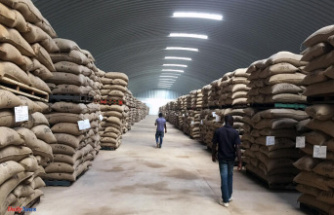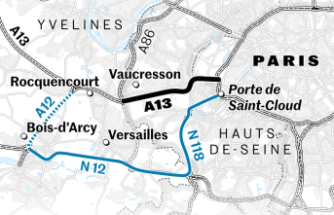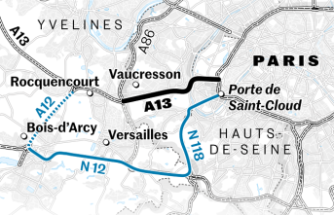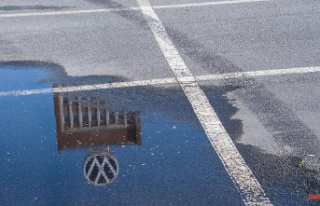The low water affects shipping traffic nationwide. Because of the low level, ships cannot be fully loaded, and trucks and trains offer few alternatives. Already in 2018, the extreme low water caused billions in losses. There is also a risk of deterioration in the coming days.
Skipper Daniel Cornelis Hartog looks down from his wheelhouse 14 meters down the Rhine at the world-famous Loreley rock: "This gravel bank is also new. Otherwise water flows over it here." It has hardly rained for weeks, water levels are falling, shore areas are drying up, new islands are rising. The low water is increasingly affecting inland shipping nationwide. Memories of 2018 are awakened: At that time, with extremely low water levels, tankers transported so little fuel that some filling stations temporarily ran dry. Will it get worse in 2022?
The German Weather Service predicts little rain in midsummer for the next few days. In the course of climate change, experts generally expect more low water phases. The Rhineland-Palatinate Interior Minister Roger Lewentz from the SPD lives in Kamp-Bornhofen am Rhein and says: "The difference to the low water in 2018 is that we have it much earlier in the year now." In 2018, the water level near Kaub in the Upper Middle Rhine Valley World Heritage Site only dropped to its record value of 25 centimeters on October 22nd. So there is still plenty of time for further falling water levels before the autumn and winter precipitation is expected. The arbitrarily attached river gauges show only a relative and not an absolute water depth.
Michel Girard, like Hartog captain on the container ship "Alorba", says: "We can only load a third or a quarter." Otherwise there is a risk of running aground on the river bed. The "Alorba" forms a so-called pushed convoy, 183 meters long and 23 meters wide, with a ship coupled in front without a motor (lighter) plus two lighters moored to the side. "We loaded 1,400 tons," explains Girard. Garden furniture, electric scooters, bicycles and horse saddles are in the containers. "1600 tons would be our limit," says Girard. "Normally we could load 5000 tons." His colleague Hartog suspects: "Even if it rains as little throughout August as it did in July, it's uncertain whether we'll still be driving in September."
In 2018, billions in losses are said to have occurred because many inland cargo ships could only be partially loaded. Some passenger ships and ferries ceased service at the time - and even now they can no longer approach all the piers.
According to the Federal Association of German Inland Shipping (BDB), based in Duisburg, there have been no freighters on the Elbe for weeks due to low water. There are around 7,350 kilometers of federal waterways - large rivers and canals. The Rhine is one of the busiest waterways in the world. According to the BDB, around 10,000 cargo ships including lighters are on the move in Europe, including around 2,000 ships registered in Germany.
In the case of rivers with barrages such as the Moselle, Main and Neckar, low water is less of a problem because their level can be regulated. The Rhine is no longer dammed north of Iffezheim in Baden-Württemberg. So not with the Loreley either. The "Alorba" has to wait at this winding and current-rich bottleneck in the World Heritage Upper Middle Rhine Valley with what is probably the highest density of castles in the world. Skipper Hartog looks at a kind of giant traffic light, the so-called vision, which shows two crossbars. "Three ships are coming towards us. They are going to the valley (downstream) and are less able to stop, so they have the right of way," says Hartog. Day-trippers in bathing suits cavort on the gravel bank that has emerged. In addition, tourists on a campsite pull out their mobile phones to photograph or film the pushed convoy in front of the Loreley in the evening sun. Some wave.
According to BDB Managing Director Jens Schwanen, the low water intensifies the scramble for scarce shipping space in times of the Ukraine war and the energy crisis. In addition to the already high demand from industry, agriculture and trade, there would be coal transport when coal-fired power plants are restarted and, initially, the transport of Ukrainian grain. "The number of barges is limited," says Schwanen. "Trucks are not a fundamental alternative because we transport so much larger quantities. Even a 110-meter ship can transport up to 3,000 tons," explains the BDB boss. "Distribute that to trucks."
And train companies? These would also have to serve a strong demand - with a total of too few wagons and train drivers. In his own words, Schwanen is less concerned about the earnings of the bargemen - the magic word here is small water surcharge: Freight customers have to pay this extra at low water depending on the water level and contract. This can make transport noticeably more expensive for them.
The BDB managing director is more concerned with the restrictions on federal waterways. For example, the Scharnebeck ship lift on the Elbe Lateral Canal, which cannot accommodate a 110-meter barge and where a new building is being built. The urgently needed deepening of the Lower Main to Aschaffenburg in Bavaria is not even in the planning stage. The elimination of six flat areas in the Upper Middle Rhine Valley, a shipping bottleneck, is particularly important to the BDB. Between Wiesbaden and St. Goar, the fairway is to be deepened from a guaranteed 1.90 meters to 2.10 meters throughout.
Federal Transport Minister Volker Wissing from the FDP says: "This is a huge project." Completion will take until the early 2030s. The costs amounted to around 180 million euros, around 40 percent of which for ecological accompanying measures. "This is the project from the Federal Transport Routes Plan with the highest cost-benefit ratio," emphasizes Wissing. "There is a clear need to shift more traffic from road to rail and waterways."
The BDB fears long delays in the already long-term river development: The government draft for the federal budget for 2023 provides for a reduction in the waterway budget by around 360 million euros. The Federal Ministry of Transport refers to expiring special effects such as the immediate climate protection program with additional money for the transport routes of inland navigation. In 2024, the waterway budget should increase again by around 260 million to around 1.6 billion euros.
Can new flat-bottomed ships be a solution to more low water? The chemical giant BASF increasingly wants to rely on them. The BDB thinks that's a good thing, but refers to the around 2,000 freight ships registered in Germany: This path is very tedious. The "Alorba" continues up the Rhine at times seven, times six and when the current is very strong, only four kilometers per hour - pedestrian speed. According to Girard, the two 1,500 hp engines in the convoy need a total of 370 liters of diesel per hour. He goes to sleep in the back of the ship to relieve his colleague Hartog at around 4 a.m. - the "Alorba" sails day and night.












